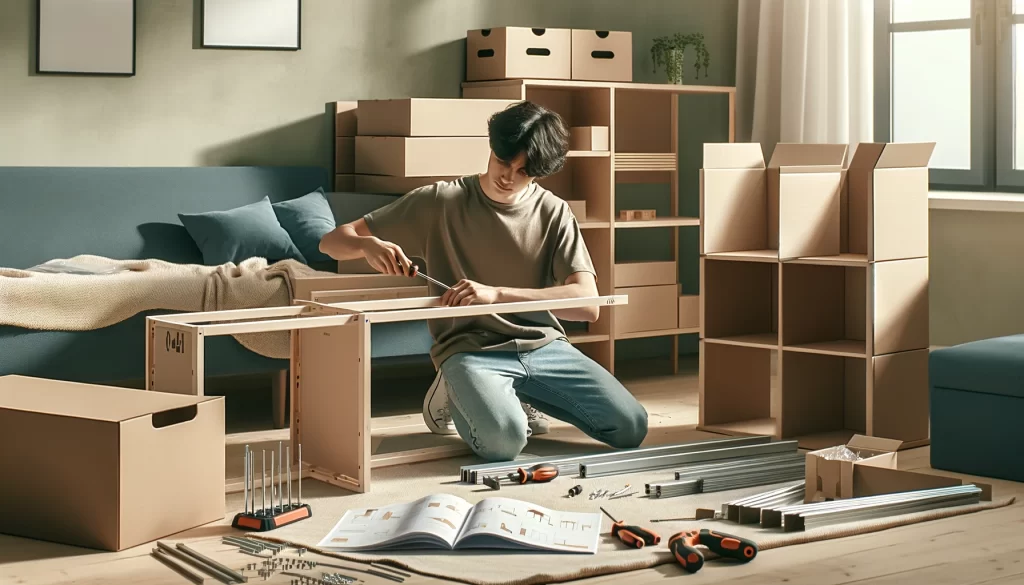Table of Contents
TogglePreparing for Assembly
Before you dive into assembling your flat-pack furniture, it’s crucial to properly prepare for the task at hand. Taking the time to lay out all the pieces and hardware, reviewing the instructions carefully, and ensuring you have the correct tools will set you up for a successful assembly process.
Lay out all pieces and hardware: Start by emptying the contents of the flat-pack box and laying out all the pieces and hardware in an organized manner. This will allow you to easily identify and access each component as you progress through the assembly steps. It’s also a good opportunity to make sure you have all the necessary parts and that nothing is missing.
Review the instructions carefully: Take the time to thoroughly read and understand the assembly instructions provided with your flat-pack furniture. Pay attention to any diagrams or illustrations that accompany the text. Familiarize yourself with the order of assembly and any specific steps or warnings mentioned in the instructions. This will help you avoid mistakes and ensure a smooth assembly process.
Use the correct tools: Using the right tools is essential for efficient and accurate assembly. Check the instructions or packaging to identify the tools required for the job. Common tools may include screwdrivers, Allen wrenches, and hammers. Make sure you have the necessary tools on hand before you begin. Using improper tools can lead to damage or improper assembly of your furniture.
By taking the time to properly prepare for assembly, you’ll set yourself up for success and make the process much smoother. Lay out all the pieces and hardware, review the instructions carefully, and gather the correct tools. With these steps completed, you’ll be ready to move on to the actual assembly of your flat-pack furniture.
Laying out all pieces and hardware
Once you’re ready to assemble your flat-pack furniture, the first step is to lay out all the pieces and hardware in a clear and organized manner. This initial preparation will save you time and frustration as you progress through the assembly process.
Start by emptying the contents of the flat-pack box onto a clean and spacious surface. Take care to handle the pieces gently to avoid any damage or scratches. Sort the components into groups based on their similarities, such as panels, screws, and brackets. This will make it easier to locate the necessary parts as you follow the instructions.
As you lay out the pieces, take a moment to familiarize yourself with each one. Identify any labels or markings that may indicate their purpose or location in the final assembly. This will help you gain a better understanding of how the different components fit together and ensure that you’re using the correct parts in the right places.
Once all the pieces are laid out, it’s a good idea to do a quick inventory check. Compare the number of components with the list provided in the assembly instructions. This will help you identify any missing or extra parts, allowing you to address the issue before you begin assembling. If you discover any discrepancies, reach out to the manufacturer or retailer for assistance.
Laying out all the pieces and hardware before you start assembling your flat-pack furniture sets the stage for a smooth and efficient process. It helps you visually understand the components, ensures you have all the necessary parts, and allows for easy access as you progress through the assembly steps. With everything organized and ready to go, you’ll be well-prepared to tackle the next stages of the assembly process.
Reviewing the instructions carefully
Before you start assembling your flat-pack furniture, it’s essential to take the time to review the instructions provided. The instructions serve as your roadmap to successful assembly and ensure that you complete each step correctly.
Begin by reading through the instructions from start to finish. Pay close attention to any diagrams, illustrations, or labeled parts that accompany the text. These visual aids can provide valuable insights into how the furniture pieces fit together and help you understand the assembly process more easily.
As you review the instructions, make note of any specific warnings, cautions, or special considerations mentioned. These instructions may include important safety precautions or tips to ensure the stability and longevity of your furniture. By following these guidelines, you can prevent accidents, avoid damage, and ensure that your furniture is assembled correctly.
It’s also helpful to identify the order of assembly outlined in the instructions. This will give you a clear understanding of the sequence in which the different components should be put together. Following the correct order will make the assembly process smoother and more efficient.
If you come across any unfamiliar terms or unclear instructions, don’t hesitate to consult additional resources. Online video tutorials or forums dedicated to furniture assembly can provide further guidance and clarification. It’s better to seek clarification before proceeding rather than risking mistakes or improper assembly.
By thoroughly reviewing the instructions before you begin, you’ll have a solid understanding of the assembly process and be better equipped to tackle each step confidently. Take the time to familiarize yourself with the instructions, pay attention to any warnings or special considerations, and seek additional resources if needed. With a clear understanding of the instructions, you’ll be well-prepared to assemble your flat-pack furniture successfully.
Using the correct tools
When it comes to assembling flat-pack furniture, using the correct tools is essential. The right tools not only make the assembly process easier but also ensure that the furniture is properly constructed and secure. Before you begin, gather the necessary tools to ensure a smooth and successful assembly.
Start by checking the assembly instructions or packaging for a list of required tools. Common tools needed for flat-pack furniture assembly may include screwdrivers, Allen wrenches, hammers, and pliers. Make sure you have the appropriate sizes and types of tools to match the hardware provided with your furniture.
Using the correct tools is crucial for several reasons. First, it ensures that you have the necessary leverage and grip to tighten screws, bolts, and other fasteners securely. Using improper tools can lead to stripped screws or loose connections, compromising the stability of the furniture.
Second, using the correct tools helps prevent damage to the furniture and its components. For example, using a screwdriver that is too large or too small can result in scratches or dents. By using the right tools, you can minimize the risk of accidental damage and keep your furniture looking its best.
Lastly, using the correct tools saves you time and frustration. The right tools are designed to make the assembly process more efficient and straightforward. They allow you to work with ease and precision, ensuring that each step is completed accurately.
If you don’t have the necessary tools on hand, consider borrowing or purchasing them before you begin the assembly. Investing in a basic toolkit can be a worthwhile investment, as it will come in handy for future projects as well.
By using the correct tools, you’ll have a smoother and more successful flat-pack furniture assembly experience. Gather the necessary tools before you start, and make sure you have the right sizes and types for the job. With the proper tools in hand, you’ll be well-prepared to tackle the assembly process with confidence.
Assembling the Furniture
With all the necessary preparations completed, it’s time to dive into the actual assembly of your flat-pack furniture. Follow these steps to ensure a smooth and successful assembly process:
Choose a suitable surface: Before you start assembling, select a soft surface to work on, such as a carpet or a blanket. This will help protect the furniture from scratches and damage during assembly. Avoid hard surfaces that could potentially cause dents or marks on the furniture.
Start with the largest pieces: Begin the assembly process by tackling the largest and most prominent pieces of the furniture. These pieces often form the foundation or framework of the furniture, and assembling them first will provide a solid structure to build upon. Refer to the instructions for guidance on which pieces to start with.
Tighten all screws partially, then fully: As you assemble the furniture, it’s important to tighten the screws gradually. Start by loosely tightening each screw, and once all the screws are partially tightened, go back and fully tighten them. This approach ensures that the pieces are aligned correctly and allows for any necessary adjustments before final tightening.
Double-check for sturdiness: Once you’ve completed the initial assembly, take a moment to double-check the sturdiness of the furniture. Give it a gentle shake or apply light pressure to ensure that all the components are securely connected. If you notice any wobbling or instability, review the assembly steps and make any necessary adjustments.
Throughout the assembly process, it’s important to follow the instructions carefully, paying attention to any specific steps or warnings. Take your time and work methodically, ensuring that each piece is properly aligned and connected. If you encounter any difficulties or uncertainties, refer back to the instructions or seek assistance from the manufacturer or retailer.
By following these steps and taking a systematic approach to assembly, you’ll be able to assemble your flat-pack furniture with confidence. Remember to choose a suitable surface, start with the largest pieces, tighten screws gradually, and double-check for sturdiness. With each step completed thoughtfully, you’ll soon have a fully assembled piece of furniture ready to be enjoyed in your space.
Choosing a suitable surface
When assembling flat-pack furniture, it’s important to choose a suitable surface to work on. The surface you select can impact the stability of the furniture and protect it from potential damage during the assembly process. Here are some considerations to keep in mind:
Select a soft surface: Opt for a soft surface, such as a carpeted floor, a blanket, or a large table covered with a soft cloth. A soft surface helps cushion the furniture and prevents scratches or dents while you assemble it. Avoid hard surfaces like concrete or hardwood floors, as they can cause damage to the furniture or make it unstable.
Avoid uneven or unstable surfaces: Ensure that the surface you choose is level and stable. Uneven surfaces can lead to wobbling or misalignment during assembly, affecting the overall stability of the furniture. If you’re working on a table, make sure it’s sturdy and doesn’t wobble. If using the floor, check for any uneven spots or bumps.
Provide ample space: Make sure the surface you choose provides enough space to lay out all the components and move around comfortably. This will allow you to organize the pieces, follow the assembly instructions, and maneuver the furniture without any restrictions. Adequate space will also help prevent accidental damage or knocking over of parts.
Consider using a drop cloth: If you’re assembling the furniture on a hard surface, such as a tiled floor, consider using a drop cloth or a thick blanket to provide a layer of protection. This will help prevent any scratches or damage to the furniture or the floor surface.
By choosing a suitable surface to assemble your flat-pack furniture, you create a stable and safe environment for the assembly process. A soft surface cushions the furniture, prevents damage, and ensures stability. Remember to select a level and stable surface, provide ample space, and consider using a drop cloth if necessary. With the right surface, you’ll be able to assemble your furniture with ease and confidence.
Starting with the largest pieces
When assembling flat-pack furniture, it’s often best to begin with the largest and most prominent pieces. These pieces typically form the foundation or framework of the furniture, and assembling them first provides a solid structure to build upon. Here’s why starting with the largest pieces is a smart approach:
Establishes stability: By starting with the largest pieces, you create a stable base for the rest of the assembly process. These pieces often serve as the main support or framework, and assembling them first ensures that the furniture is sturdy and secure. It’s like building a strong foundation for a house before adding the walls and roof.
Provides a visual guide: The largest pieces of flat-pack furniture are usually the most recognizable and distinguishable. Assembling them first gives you a clear visual guide for the rest of the assembly process. You can easily identify how the smaller components fit into the larger structure, making it easier to follow the instructions and ensure proper alignment.
Streamlines the assembly process: Starting with the largest pieces allows you to tackle the most time-consuming and complex steps early on. Once these pieces are assembled, the subsequent steps often involve attaching smaller components or adding finishing touches. This streamlined approach helps maintain focus and momentum throughout the assembly process.
Builds confidence: Successfully assembling the largest pieces first gives you a sense of accomplishment and builds confidence as you progress through the remaining steps. It’s like solving the most challenging puzzle pieces before moving on to the easier ones. This boost in confidence can motivate you to continue assembling the furniture with precision and attention to detail.
By starting with the largest pieces of your flat-pack furniture, you establish stability, gain a visual guide, streamline the assembly process, and build confidence. Remember to carefully follow the instructions provided, ensuring that each piece is properly aligned and securely connected. With a strong foundation in place, you’ll be well on your way to completing the assembly of your furniture.
Tightening screws partially then fully
When assembling flat-pack furniture, it’s important to tighten screws in a specific manner to ensure proper alignment and stability. The recommended approach is to tighten screws partially first, and then fully tighten them. Here’s why this method is crucial for successful assembly:
Allows for adjustments: By tightening screws partially first, you create some flexibility in the assembly. This allows you to make any necessary adjustments or corrections before fully securing the pieces together. It’s like fitting puzzle pieces together loosely before finalizing the connection.
Ensures proper alignment: Partially tightening screws before fully tightening them helps ensure that the pieces are aligned correctly. As you tighten the screws, the components may shift slightly, and this initial tightening allows you to guide them into the correct position. It’s like using a clamp to hold two pieces in place while you secure them together.
Maintains stability: Gradually tightening screws from partial to full ensures that the furniture is stable and secure. It allows you to evenly distribute the pressure on the joints or connections, minimizing the risk of wobbling or loosening over time. It’s like tightening the bolts on a bicycle wheel, ensuring that each one is tightened evenly for a smooth and stable ride.
Prevents damage: Over-tightening screws can lead to stripped holes or damaged components. By initially tightening screws partially, you reduce the risk of applying excessive force and causing damage. This method helps maintain the integrity of the furniture and ensures that the connections are secure without compromising their structural integrity.
When assembling your flat-pack furniture, remember to tighten screws partially first, and then fully tighten them. This approach allows for adjustments, ensures proper alignment, maintains stability, and prevents damage. Follow the instructions provided, and use the appropriate tools to tighten the screws. With this method, you’ll achieve a secure and well-assembled piece of furniture.
Double-checking for sturdiness
After completing the assembly of your flat-pack furniture, it’s important to take a moment to double-check for sturdiness. This step ensures that all the components are securely connected and that the furniture is stable and safe to use. Here’s why double-checking for sturdiness is crucial:
Ensures safety: Double-checking for sturdiness is essential for the safety of yourself and others. By ensuring that all the connections are secure, you minimize the risk of accidents or injuries caused by unstable furniture. It’s like double-checking the seatbelt in your car before hitting the road.
Confirms proper assembly: Taking the time to double-check for sturdiness allows you to confirm that the furniture has been assembled correctly. It gives you the opportunity to review the assembly steps and ensure that all the pieces are in their proper places. It’s like proofreading a document to make sure there are no errors or inconsistencies.
Identifies any loose connections: During the assembly process, some connections may become slightly loose. By double-checking for sturdiness, you can identify any loose screws or fittings and tighten them properly. This helps maintain the integrity and stability of the furniture. It’s like tightening the laces on your shoes to prevent them from coming undone.
Provides peace of mind: Double-checking for sturdiness gives you peace of mind knowing that your furniture is securely assembled. It allows you to have confidence in the stability and durability of the furniture, ensuring that it will withstand regular use. It’s like knowing that your home’s foundation is solid and secure.
When double-checking for sturdiness, gently shake or apply light pressure to the furniture to test its stability. If you notice any wobbling or instability, review the assembly steps and make any necessary adjustments. Ensure that all screws and fittings are properly tightened and that the furniture feels solid and secure.
By taking the time to double-check for sturdiness, you can ensure that your flat-pack furniture is safe, properly assembled, and stable. Prioritizing safety and stability will provide you with peace of mind and allow you to enjoy your furniture with confidence.
Additional Tips and Considerations
Assembling flat-pack furniture can be a rewarding experience when done correctly. Here are some additional tips and considerations to keep in mind to ensure a successful assembly:
Attaching to the wall if necessary: Some flat-pack furniture, such as bookcases or cabinets, may need to be anchored to the wall for stability and safety. Follow the instructions provided to determine if wall attachments are required and ensure that you use appropriate hardware and follow proper installation techniques.
Avoiding scratches and damage: Protect your furniture and the surrounding surfaces by using a soft cloth or blanket as a barrier when assembling. This will help prevent scratches or dents during the assembly process. Additionally, handle the components with care to avoid accidental damage.
Ensuring proper alignment and fit: Pay close attention to the alignment of the components as you assemble the furniture. Check that pieces fit together snugly and that any pre-drilled holes line up correctly. If you encounter any difficulties, double-check the instructions and make any necessary adjustments.
Seeking assistance if needed: If you’re struggling with the assembly process or if the furniture is particularly large or complex, don’t hesitate to seek assistance. Involve a friend or family member to help with lifting and holding components, or reach out to the manufacturer or retailer for guidance.
Remember that each piece of flat-pack furniture may have specific instructions and considerations, so always refer to the provided instructions for the best results. Take your time, work methodically, and make sure to follow all safety precautions and recommendations.
By keeping these additional tips and considerations in mind, you’ll be well-prepared to assemble your flat-pack furniture successfully. Attach the furniture to the wall if necessary, protect against scratches and damage, ensure proper alignment, and seek assistance when needed. With careful attention to detail, you’ll have a sturdy and well-assembled piece of furniture to enjoy in your space.
Attaching to the wall if necessary
When assembling certain types of flat-pack furniture, it may be necessary to attach the furniture to the wall for added stability and safety. This step is particularly important for items like bookcases, cabinets, or shelving units that have the potential to tip over. Here’s why attaching furniture to the wall is crucial:
Enhances stability: Attaching furniture to the wall significantly increases its stability, preventing it from tipping over or becoming unsteady. This is especially important if you have children or pets in your home who may inadvertently apply force to the furniture.
Ensures safety: Wall attachments help minimize the risk of accidents and injuries caused by toppling furniture. By securely fastening the furniture to the wall, you create a safer environment, reducing the chances of it falling over and causing harm to yourself or others.
Follow manufacturer’s instructions: Always refer to the manufacturer’s instructions for specific guidance on how to attach the furniture to the wall. The instructions will provide details on the appropriate hardware to use, the placement of wall brackets or anchors, and the recommended installation technique.
Use proper hardware: Use the recommended hardware provided by the manufacturer to ensure a secure attachment. This may include wall brackets, screws, or anchors specifically designed for furniture anchoring. Using the correct hardware is crucial for the effectiveness of the attachment.
Seek professional assistance if needed: If you’re unsure about the process or if you’re dealing with heavy or complex furniture, consider seeking professional assistance. A professional can ensure that the furniture is properly attached to the wall, minimizing the risk of errors or inadequate installation.
Remember, attaching furniture to the wall is an additional safety measure to prevent accidents and ensure stability. If the furniture you’re assembling requires wall attachments, carefully follow the manufacturer’s instructions and use the appropriate hardware. By taking these precautions, you can enjoy your furniture with peace of mind, knowing that it is securely anchored to the wall.
Avoiding scratches and damage
When assembling flat-pack furniture, it’s important to take precautions to avoid scratches and damage to both the furniture and the surrounding surfaces. By following these tips, you can ensure that your furniture remains in pristine condition:
Use a soft surface: Assemble your furniture on a soft surface, such as a carpet or a blanket. This provides a cushioning effect and helps protect the furniture from scratches or dents. Avoid assembling on hard surfaces like concrete or hardwood floors, as they can potentially cause damage to the furniture.
Handle with care: Treat the furniture components with care to avoid accidental damage. Avoid dragging or dropping the pieces, as this can cause scratches or dents. Instead, lift and place them gently during the assembly process. It’s like handling delicate china to avoid breakage.
Protect the furniture: If you need to flip or turn the furniture during assembly, consider using a soft cloth or blanket as a protective layer. This helps prevent scratches or marks on the surface of the furniture. It’s like using a coaster to protect a table from water rings.
Use the right tools: Ensure that you’re using the correct tools for assembly. Using improper tools can lead to slips or damage to the furniture. Follow the manufacturer’s instructions and use the recommended tools to avoid scratches or stripped screws.
Follow the instructions: Carefully follow the assembly instructions provided by the manufacturer. The instructions often include specific guidance on how to handle the furniture components to avoid damage. By following the instructions, you can minimize the risk of scratches or other forms of damage.
By taking these precautions, you can avoid scratches and damage during the assembly of your flat-pack furniture. Use a soft surface, handle the components with care, protect the furniture with a cloth or blanket when necessary, use the right tools, and follow the instructions provided. This will help ensure that your furniture remains in excellent condition as you complete the assembly process.
Ensuring proper alignment and fit
When assembling flat-pack furniture, ensuring proper alignment and fit is crucial for a successful and sturdy finished product. Here are some tips to help you achieve proper alignment and fit during the assembly process:
Follow the instructions: Carefully follow the assembly instructions provided by the manufacturer. The instructions typically include step-by-step guidance on how to align and fit the different components. Pay close attention to any specific instructions or diagrams that show proper alignment.
Check for pre-drilled holes: Many flat-pack furniture pieces come with pre-drilled holes to guide the assembly process. Ensure that the holes are properly aligned before inserting screws or other fasteners. If a hole is not aligned correctly, double-check the surrounding components and make any necessary adjustments.
Make minor adjustments: If you encounter difficulty in aligning the components, try making minor adjustments. Gently wiggle or shift the pieces to find the best fit. Be cautious not to force the components together, as this can lead to damage or misalignment.
Use a rubber mallet or soft hammer: In some cases, gently tapping certain components with a rubber mallet or a soft hammer can help align and fit them together. Use light and controlled taps to avoid causing damage to the furniture.
Check for gaps or unevenness: As you assemble the furniture, be mindful of any gaps or unevenness between components. These may indicate a misalignment or improper fit. Take the time to adjust the pieces until they fit together snugly and evenly.
Seek professional assistance if needed: If you’re struggling to achieve proper alignment and fit, don’t hesitate to seek professional assistance. A professional can provide guidance, identify potential issues, and help ensure that the furniture is assembled correctly.
By following these tips, you can ensure proper alignment and fit during the assembly of your flat-pack furniture. Carefully follow the instructions, check for pre-drilled holes, make minor adjustments as needed, use a rubber mallet or soft hammer when appropriate, and check for gaps or unevenness. With proper alignment and fit, you’ll have a sturdy and well-assembled piece of furniture to enjoy in your space.
Seeking assistance if needed
Assembling flat-pack furniture can sometimes be challenging, especially if you’re working with complex or heavy pieces. If you find yourself struggling or feeling overwhelmed during the assembly process, don’t hesitate to seek assistance. Here’s why seeking help when needed can make a significant difference:
Expert guidance: Seeking assistance allows you to benefit from the expertise of others. Whether it’s a friend, family member, or professional, they can provide guidance, share their knowledge, and offer solutions to any assembly challenges you may encounter.
Physical support: Some flat-pack furniture pieces may be heavy or require multiple people to lift and maneuver. Having an extra set of hands can make the assembly process much easier and safer. They can help you lift and position the components, reducing the risk of strain or injury.
Problem-solving: If you’re facing difficulties aligning components or troubleshooting assembly issues, seeking assistance can bring fresh perspectives and problem-solving skills. Another person may notice something you missed or suggest alternative approaches to overcome obstacles.
Save time and frustration: Seeking assistance can save you time and frustration. Instead of spending hours struggling with a particular step, someone with experience can help you navigate through it more efficiently. This can help you avoid unnecessary stress and ensure a smoother assembly process.
Professional help: For complex or large-scale furniture assembly, it may be beneficial to hire a professional assembly service. These professionals have the expertise, tools, and experience to assemble your furniture quickly and correctly. They can ensure that the furniture is sturdy, safe, and properly assembled.
Remember, there’s no shame in seeking assistance when needed. Whether it’s asking a friend for help, consulting with a professional, or hiring an assembly service, seeking assistance can make a significant difference in your assembly experience. Don’t hesitate to reach out for support when you need it.





